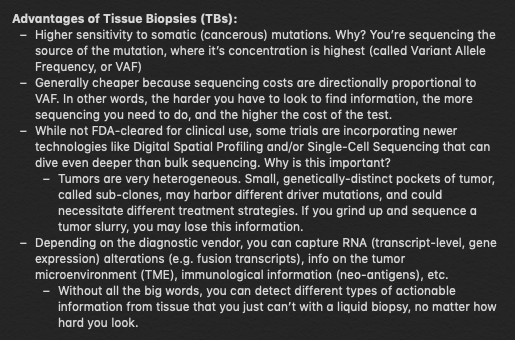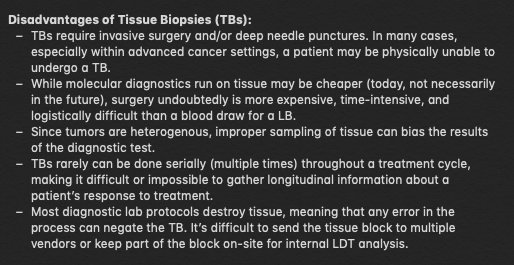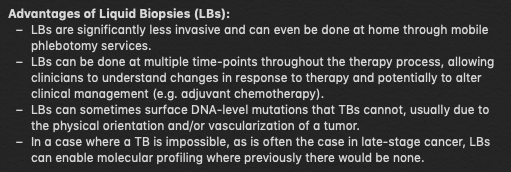Liquid and Tissue Biopsies: Comparing and Contrasting
(A Thread https://abs.twimg.com/emoji/v2/... draggable="false" alt="📜" title="Schriftrolle" aria-label="Emoji: Schriftrolle">)
https://abs.twimg.com/emoji/v2/... draggable="false" alt="📜" title="Schriftrolle" aria-label="Emoji: Schriftrolle">)
Last week, you voted for this topic to be discussed. Feel free to comment, criticize, and critique! https://twitter.com/sbarnettARK/status/1296530370977058818">https://twitter.com/sbarnettA...
(A Thread
Last week, you voted for this topic to be discussed. Feel free to comment, criticize, and critique! https://twitter.com/sbarnettARK/status/1296530370977058818">https://twitter.com/sbarnettA...
1/
Tissue biopsies (TBs) and Liquid Biopsies (LBs) are different ways oncologists gather molecular information on a patient& #39;s tumor. For example, genetic mutations within tumors, once identified, can be used to guide treatment decisions.
Tissue biopsies (TBs) and Liquid Biopsies (LBs) are different ways oncologists gather molecular information on a patient& #39;s tumor. For example, genetic mutations within tumors, once identified, can be used to guide treatment decisions.
2/
I& #39;ll begin with TBs.
TBs involve gathering a block of tumor tissue via surgery or needle puncture. While TBs have been around for decades, we& #39;ve begun to use more comprehensive tools, such as next-gen sequencing (NGS) to analyze tissue samples.
I& #39;ll begin with TBs.
TBs involve gathering a block of tumor tissue via surgery or needle puncture. While TBs have been around for decades, we& #39;ve begun to use more comprehensive tools, such as next-gen sequencing (NGS) to analyze tissue samples.
3/
TBs can be analyzed by an on-site clinical pathologist inside a hospital& #39;s own lab through what& #39;s called a Laboratory Developed Test (or LDT). TBs can also be fixed (e.g. Formalin-Fixed Paraffin-Embedded Tissue, FFPE) and shipped to a centralized diagnostic provider.
TBs can be analyzed by an on-site clinical pathologist inside a hospital& #39;s own lab through what& #39;s called a Laboratory Developed Test (or LDT). TBs can also be fixed (e.g. Formalin-Fixed Paraffin-Embedded Tissue, FFPE) and shipped to a centralized diagnostic provider.
4/
Should a hospital not have the resources or desire to create an on-site LDT, they can purchase self-contained analysis kits called In-Vitro Diagnostics (IVDs). This is especially valuable for local or regional hospitals where 80% of cancer patients are treated.
Should a hospital not have the resources or desire to create an on-site LDT, they can purchase self-contained analysis kits called In-Vitro Diagnostics (IVDs). This is especially valuable for local or regional hospitals where 80% of cancer patients are treated.
5/
Now, TBs, just like LBs, which I& #39;ll talk about in a moment, have advantages and disadvantages, summarized below:
Bottom Line:
We think TBs, now and in the future, are absolutely vital to cancer care. LBs will not replace TBs, except in cases where TBs aren& #39;t possible.
Now, TBs, just like LBs, which I& #39;ll talk about in a moment, have advantages and disadvantages, summarized below:
Bottom Line:
We think TBs, now and in the future, are absolutely vital to cancer care. LBs will not replace TBs, except in cases where TBs aren& #39;t possible.
6/
Now, let& #39;s discuss LBs. First off, be aware that LBs have many more clinical use-cases than TBs do. I summarize them here, but am happy to expand in the comments: https://twitter.com/sbarnettARK/status/1288453687761932293">https://twitter.com/sbarnettA...
Now, let& #39;s discuss LBs. First off, be aware that LBs have many more clinical use-cases than TBs do. I summarize them here, but am happy to expand in the comments: https://twitter.com/sbarnettARK/status/1288453687761932293">https://twitter.com/sbarnettA...
7/
LBs analyze small fragments of tumor-derived DNA (ctDNA) swimming in a cancer patient& #39;s bloodstream. These only recently became economically feasible as they involve lots of machine learning, synthetic biology, and ultra-deep sequencing because VAF is so low relative to TB.
LBs analyze small fragments of tumor-derived DNA (ctDNA) swimming in a cancer patient& #39;s bloodstream. These only recently became economically feasible as they involve lots of machine learning, synthetic biology, and ultra-deep sequencing because VAF is so low relative to TB.
8/
Cancer cells turnover more rapidly than healthy cells, so: cell nucleus breaks, cancer DNA leaks into blood, captured in blood draw, then sequenced. Similar to TBs, LBs can be analyzed via central LDT, on-site LDT, or on-site IVD.
Cancer cells turnover more rapidly than healthy cells, so: cell nucleus breaks, cancer DNA leaks into blood, captured in blood draw, then sequenced. Similar to TBs, LBs can be analyzed via central LDT, on-site LDT, or on-site IVD.
9/
Let& #39;s go through the advantages and disadvantages of LBs:
As you can see, neither approach is perfect, but together, there are a ton of obvious synergies. I& #39;ll end by explaining what we think a near-term, achievable goal could be.
Let& #39;s go through the advantages and disadvantages of LBs:
As you can see, neither approach is perfect, but together, there are a ton of obvious synergies. I& #39;ll end by explaining what we think a near-term, achievable goal could be.
10/
Cancer treatment is a process, usually involving surgery, chemotherapy, and radiation. Treatment can change the underlying biology through evolution-like processes, which I& #39;ve summarized in a previous thread: https://twitter.com/sbarnettARK/status/1293626231070621703">https://twitter.com/sbarnettA...
Cancer treatment is a process, usually involving surgery, chemotherapy, and radiation. Treatment can change the underlying biology through evolution-like processes, which I& #39;ve summarized in a previous thread: https://twitter.com/sbarnettARK/status/1293626231070621703">https://twitter.com/sbarnettA...
11/
The future of diagnostic medicine, we think, should involve both TBs and LBs whenever possible: TBs for upfront, comprehensive analysis, and LBs for longitudinal monitoring.
The strongest vendors likely will be the ones doing both, both from a cost-standpoint and accuracy.
The future of diagnostic medicine, we think, should involve both TBs and LBs whenever possible: TBs for upfront, comprehensive analysis, and LBs for longitudinal monitoring.
The strongest vendors likely will be the ones doing both, both from a cost-standpoint and accuracy.
12/
Moreover, we think the strongest vendors will be competent w/ centralized LDTs and decentralized IVDs for those hospitals wanting to keep things in-house (on-site is much faster too, important for acute care). There should be no delta in quality/accuracy between IVD and LDT.
Moreover, we think the strongest vendors will be competent w/ centralized LDTs and decentralized IVDs for those hospitals wanting to keep things in-house (on-site is much faster too, important for acute care). There should be no delta in quality/accuracy between IVD and LDT.
13/
Now, let& #39;s talk about patients, because they are THE most important part of the equation here. Cancer treatment is expensive. The last thing they need is diagnostic vendors tacking on test after test and hiding behind historically high reimbursement rates.
Now, let& #39;s talk about patients, because they are THE most important part of the equation here. Cancer treatment is expensive. The last thing they need is diagnostic vendors tacking on test after test and hiding behind historically high reimbursement rates.
14/
A combined LB+TB offering should be packaged together and delivered as one service, with transparent data and clear decision-support tools. We believe that aggressive R&D today enables benevolent deflation for patients, ie cheaper tests.
A combined LB+TB offering should be packaged together and delivered as one service, with transparent data and clear decision-support tools. We believe that aggressive R&D today enables benevolent deflation for patients, ie cheaper tests.
15/
In a perfect world, this service would be so cheap that it could decouple from payers, such that uninsured, underrepresented, and/or rural patients get the same level of comprehensive diagnostic information that exists in leading cancer clinics.
In a perfect world, this service would be so cheap that it could decouple from payers, such that uninsured, underrepresented, and/or rural patients get the same level of comprehensive diagnostic information that exists in leading cancer clinics.
16/
We think this is an achievable goal and one that could occur within the next few years, especially if powered by technologies on legendary cost declines, like NGS, artificial intelligence, and synthetic biology.
We think this is an achievable goal and one that could occur within the next few years, especially if powered by technologies on legendary cost declines, like NGS, artificial intelligence, and synthetic biology.

 Read on Twitter
Read on Twitter





